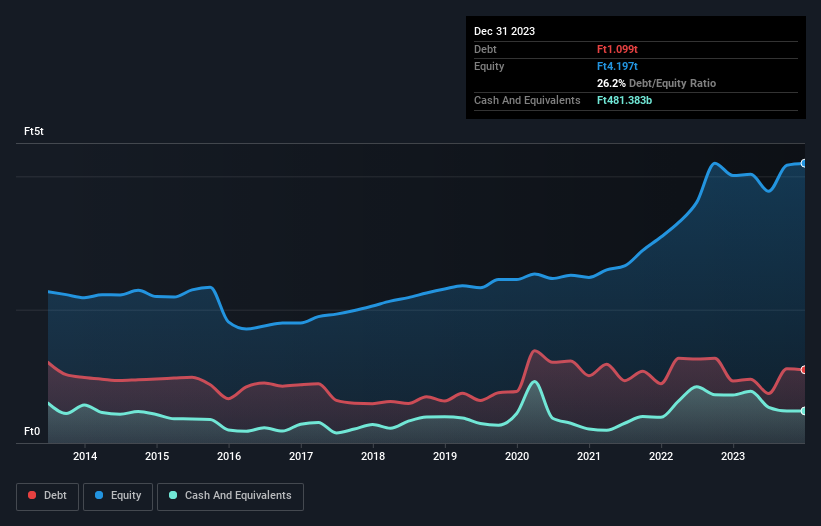- Hungary
- /
- Oil and Gas
- /
- BUSE:MOL
Is MOL Magyar Olaj- és Gázipari Nyilvánosan Muködo Részvénytársaság (BUSE:MOL) A Risky Investment?

David Iben put it well when he said, 'Volatility is not a risk we care about. What we care about is avoiding the permanent loss of capital.' It's only natural to consider a company's balance sheet when you examine how risky it is, since debt is often involved when a business collapses. We can see that MOL Magyar Olaj- és Gázipari Nyilvánosan Muködo Részvénytársaság (BUSE:MOL) does use debt in its business. But the real question is whether this debt is making the company risky.
When Is Debt A Problem?
Debt assists a business until the business has trouble paying it off, either with new capital or with free cash flow. Ultimately, if the company can't fulfill its legal obligations to repay debt, shareholders could walk away with nothing. While that is not too common, we often do see indebted companies permanently diluting shareholders because lenders force them to raise capital at a distressed price. Of course, plenty of companies use debt to fund growth, without any negative consequences. When we examine debt levels, we first consider both cash and debt levels, together.
See our latest analysis for MOL Magyar Olaj- és Gázipari Nyilvánosan Muködo Részvénytársaság
What Is MOL Magyar Olaj- és Gázipari Nyilvánosan Muködo Részvénytársaság's Debt?
As you can see below, at the end of December 2023, MOL Magyar Olaj- és Gázipari Nyilvánosan Muködo Részvénytársaság had Ft1.10t of debt, up from Ft931.2b a year ago. Click the image for more detail. On the flip side, it has Ft481.4b in cash leading to net debt of about Ft617.2b.

A Look At MOL Magyar Olaj- és Gázipari Nyilvánosan Muködo Részvénytársaság's Liabilities
According to the last reported balance sheet, MOL Magyar Olaj- és Gázipari Nyilvánosan Muködo Részvénytársaság had liabilities of Ft1.84t due within 12 months, and liabilities of Ft1.66t due beyond 12 months. On the other hand, it had cash of Ft481.4b and Ft984.3b worth of receivables due within a year. So its liabilities outweigh the sum of its cash and (near-term) receivables by Ft2.04t.
Given this deficit is actually higher than the company's market capitalization of Ft1.88t, we think shareholders really should watch MOL Magyar Olaj- és Gázipari Nyilvánosan Muködo Részvénytársaság's debt levels, like a parent watching their child ride a bike for the first time. In the scenario where the company had to clean up its balance sheet quickly, it seems likely shareholders would suffer extensive dilution.
We use two main ratios to inform us about debt levels relative to earnings. The first is net debt divided by earnings before interest, tax, depreciation, and amortization (EBITDA), while the second is how many times its earnings before interest and tax (EBIT) covers its interest expense (or its interest cover, for short). The advantage of this approach is that we take into account both the absolute quantum of debt (with net debt to EBITDA) and the actual interest expenses associated with that debt (with its interest cover ratio).
MOL Magyar Olaj- és Gázipari Nyilvánosan Muködo Részvénytársaság has a low debt to EBITDA ratio of only 0.55. And remarkably, despite having net debt, it actually received more in interest over the last twelve months than it had to pay. So it's fair to say it can handle debt like a hotshot teppanyaki chef handles cooking. In fact MOL Magyar Olaj- és Gázipari Nyilvánosan Muködo Részvénytársaság's saving grace is its low debt levels, because its EBIT has tanked 40% in the last twelve months. Falling earnings (if the trend continues) could eventually make even modest debt quite risky. The balance sheet is clearly the area to focus on when you are analysing debt. But ultimately the future profitability of the business will decide if MOL Magyar Olaj- és Gázipari Nyilvánosan Muködo Részvénytársaság can strengthen its balance sheet over time. So if you're focused on the future you can check out this free report showing analyst profit forecasts.
Finally, a company can only pay off debt with cold hard cash, not accounting profits. So we clearly need to look at whether that EBIT is leading to corresponding free cash flow. During the last three years, MOL Magyar Olaj- és Gázipari Nyilvánosan Muködo Részvénytársaság produced sturdy free cash flow equating to 57% of its EBIT, about what we'd expect. This free cash flow puts the company in a good position to pay down debt, when appropriate.
Our View
MOL Magyar Olaj- és Gázipari Nyilvánosan Muködo Részvénytársaság's EBIT growth rate and level of total liabilities definitely weigh on it, in our esteem. But its interest cover tells a very different story, and suggests some resilience. Taking the abovementioned factors together we do think MOL Magyar Olaj- és Gázipari Nyilvánosan Muködo Részvénytársaság's debt poses some risks to the business. So while that leverage does boost returns on equity, we wouldn't really want to see it increase from here. There's no doubt that we learn most about debt from the balance sheet. But ultimately, every company can contain risks that exist outside of the balance sheet. Be aware that MOL Magyar Olaj- és Gázipari Nyilvánosan Muködo Részvénytársaság is showing 2 warning signs in our investment analysis , and 1 of those can't be ignored...
When all is said and done, sometimes its easier to focus on companies that don't even need debt. Readers can access a list of growth stocks with zero net debt 100% free, right now.
New: Manage All Your Stock Portfolios in One Place
We've created the ultimate portfolio companion for stock investors, and it's free.
• Connect an unlimited number of Portfolios and see your total in one currency
• Be alerted to new Warning Signs or Risks via email or mobile
• Track the Fair Value of your stocks
Have feedback on this article? Concerned about the content? Get in touch with us directly. Alternatively, email editorial-team (at) simplywallst.com.
This article by Simply Wall St is general in nature. We provide commentary based on historical data and analyst forecasts only using an unbiased methodology and our articles are not intended to be financial advice. It does not constitute a recommendation to buy or sell any stock, and does not take account of your objectives, or your financial situation. We aim to bring you long-term focused analysis driven by fundamental data. Note that our analysis may not factor in the latest price-sensitive company announcements or qualitative material. Simply Wall St has no position in any stocks mentioned.
About BUSE:MOL
MOL Magyar Olaj- és Gázipari Nyilvánosan Muködo Részvénytársaság
Operates as an integrated oil and gas company in Hungary and internationally.
Flawless balance sheet established dividend payer.


